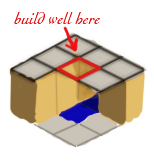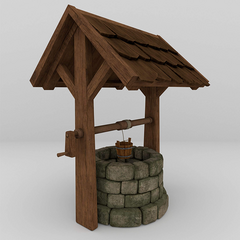- v50 information can now be added to pages in the main namespace. v0.47 information can still be found in the DF2014 namespace. See here for more details on the new versioning policy.
- Use this page to report any issues related to the migration.
Well
| This article was migrated from DF2014:Well and may be inaccurate for the current version of DF (v52.04). See this page for more information. |
|
b-m-L | |
| Construction | |
|---|---|
| Materials | Jobs |
|
1 of | |
| Purpose | |
| |
v52.04 · v0.47.05 This article is about the current version of DF.Note that some content may still need to be updated. |
- For a more advanced look at wells, see Well guide.
- It is recommended to read the entirety of this article first.
Wells are buildings that provide access to a water source for your dwarves. A well can be an important feature of a fortress, providing a clean and usually safe water supply compared to rivers, pools and cavern lakes. However, getting water from a well will neither clean nor desalinate it, so you still should make sure that the well has access to clean water.
Wells provide an emergency drinking source in case the alcohol runs out (don't let that happen!). A well is a water source that (if constructed correctly) will not freeze in the coldest weather, and should last in hot. Enemies that can swim can and will path into your fort through a well. Grates can block underwater threats, but be warned: they cannot stop building destroyers which approach from below.
A well constructed above-ground, even indoors, will not prevent the water tile beneath it from freezing. When this happens, the "empty space" requirement for the well is no longer met as the space is occupied by the ice, and the well will be dismantled into its original components (Prevent this by placing it one Z-level above the water source if it freezes). Furthermore, if the well is built in a layer with a temperature below the freezing point – that is, an ice layer in a glacier – the water will freeze within the well bucket, and the well itself will become unusable, showing a "bucket full" message. To prevent this, build the well and the hospital in the earth layers below the ice. Dump the ice inside the bucket to recover it.
Using the well 10 times will take a small amount of water from the water tile below (1/7 from that one tile), so it will eventually dry up, if not replenished. A well can be defined as a meeting hall with the q key. Un-defining the meeting area will break up any groups that are currently formed around a well, and it can immediately be re-defined if you wish.
Using a well provides the user with a happy thought, especially if you make the well with high-value chain/rope, bucket, block and mechanism, and/or the building designer produces a high-quality result. Drinking stagnant water from a well will still lead to a bad thought, and will lead to infection if used to clean a wound. If the floor of your water source is covered by a pile of mud (like the floors of underground pools in caverns) then the water drawn out will be "water laced with mud" unless there are two z-levels of water in it. Badly wounded dwarves will drink only water while recuperating, never booze, so you better have a well or water zone ready for when anyone gets injured, and certainly before the first goblins show up. Ensure you have enough buckets as well, as injured dwarves will not go to the well themselves even if it is next to their hospital bed, but require someone to bring them water in a bucket. If a well is full enough and the water is only one z-level down, the tile can also be used for fishing. When you fish "from a well", you aren't actually fishing from the well itself – you're just fishing from the tile of water beneath it, which means that the well needs to be filled all the way to the top. Dwarves will also use the well to wash themselves - this means that a well (and soap) are vital for removing contaminants such as blood, poison, etc. from your dwarves.
Building a well
When constructing a well, it is important to consider placement, safety, the source of the water, and any water pressure to avoid flooding your fortress by accident. For a wider discussion of adding a well to your fortress, see the (recommended) well guide.
Wells must have a clear vertical pathway straight down to their water source. That source can be an artificial channel, an aquifer, a river, a lake, or an artificial reservoir, so long as it has water in it that's at least 3/7 deep. Brooks can be used, but you must first channel off the surface of the brook to allow the bucket to dip into the water. The water can be any distance directly below the well, but it will take a while for the bucket to go down and back up on long distances. If there is 7/7 deep water somewhere directly below the well, then the depth of the top tile of this water does not matter.
The more common well will be created underground and draw water from a source even lower, but above-ground sources can also be used; you just have to build constructions first (typically up-stairs, walls and floors) that provide support at least one z-level above the water's level where you can then place the well.
To build a well you will need the following components:
To place a well, press the b, l keys. That will take you through the various components, and you can choose specifically from among the parts you have available in each category. A well needs to be placed over an open space with adjacent floor tiles; there does not need to be water underneath a well for it to be built, only for it to be active.
It requires a dwarf with the architecture labor designated to design, and then a mason/carpenter/metalsmith to finish the construction. Because it's designed, high-value materials can be multiplied by a high-quality effort in either or both of the steps involved, resulting in an extremely valuable piece of architecture for your fortress. The dwarves will describe a very nice well as "truly sublime".
High-value mechanisms can be created at a forge from weapon-grade metals, the most valuable being steel, iron and silver. Alternatively, you can make rock mechanisms with some gold or platinum nuggets using the detail function at a mechanic's workshop.
If a well is working properly, meaning it has direct access to water, it will display "active" when examined with q. If there is something obstructing the well, or there is not enough water, it will display "dry".
While in use by a dwarf, you can see the well's rope and bucket travel across z-levels. Although interesting, if your water source is very deep, it may take a while for a single dwarf to obtain water. This becomes especially annoying if you do not have a steady booze supply, as thirsty dwarves will swarm the well awaiting their turn.
It is possible to build wells directly above one another, and they will still function if there is water below. They will not obstruct one another, as they are not impassable structures. Hatches, floor bars and floor grates will block well functionality, if they are between it and the water, but grates and bars will not stop water from flooding out. Grates, bars and hatches will allow functionality again if opened with a lever. It is perfectly reasonable to have multiple well openings drawing from a single water source, as a well only cares about the tile in a straight line below it. Wells cannot function through a stairwell. It is possible to have obstacles beneath a well, with the well continuing to function, if the surface of the water is above the obstacles.
A well is essentially a hole in the floor, so dwarves can fall through it under the right circumstances. Using a well is safe, while fighting or flooding near a well may not be. Any dwarves who fall through may escape drowning if the water source includes an escape route.
Removal
When removing a well, the components will generally be scattered around the channeled tile, not fall down into the well. One exception is when the bucket is stuck somewhere on the way down which probably happens when a water hauling job is interrupted by a hostile creature. In this case the bucket will drop down into the water source, but the rope, block and mechanism are saved.
In an area where ice forms, a well placed directly over water that freezes will be automatically deconstructed to its original parts. When the ice melts, the parts may be lost. One solution is to leave at least one tile of empty space between your well and any outdoor water sources.
| Furniture | |
|---|---|
| Tools | |
| Access | |
| Constructions | |
| Machine and trap parts |
Axle • Gear assembly • Lever • Mechanism • Millstone • Pipe section • Pressure plate • Roller • Screw pump • Support • Trap • Water wheel • Windmill |
| Other buildings | |
| Related articles | |

|
This article or section has been rated D for Dwarf. It may include witty humour, not-so-witty humour, bad humour, in-jokes, pop culture references, and references to the Bay12 forums. Don't believe everything you read, and if you miss some of the references, don't worry. It was inevitable. |
Some humans share stories about human boys falling down wells and Dogs saving them.

